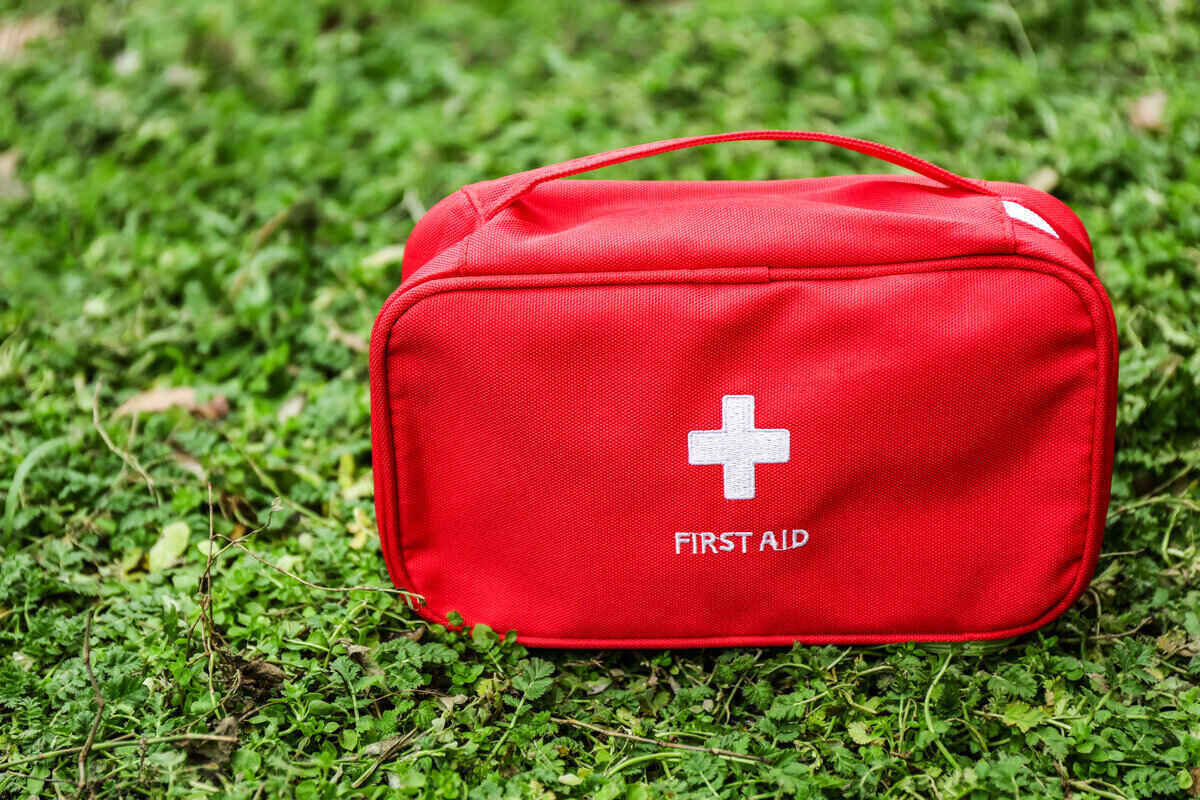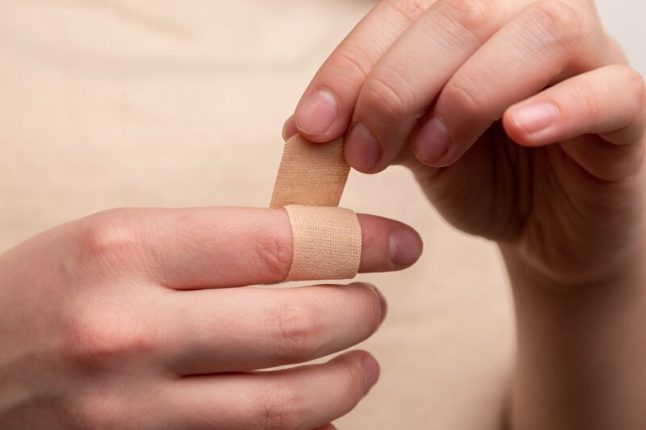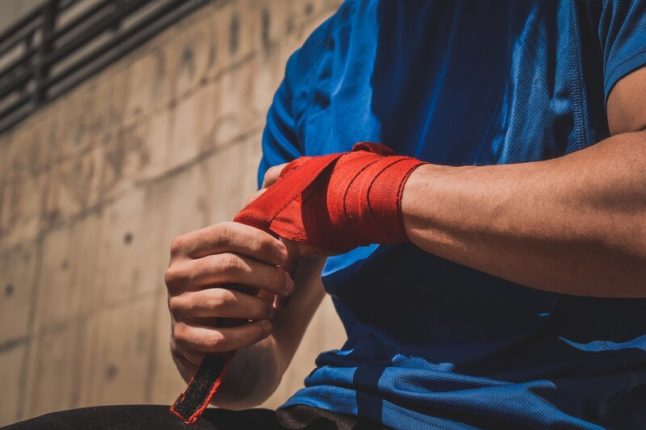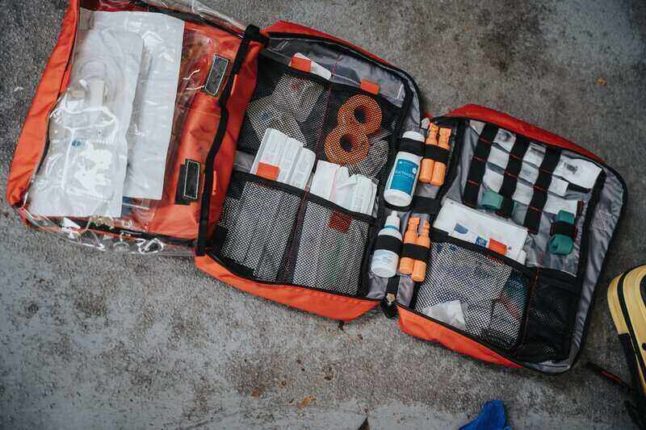
Lawn care and landscaping require the use of heavy machinery and tools designed to slice. No matter how careful you are, accidents happen. That’s why you need a first aid kit handy specific to the dangers of cutting tools, insect stings, and extreme weather.
The Occupational Safety and Health Administration (OSHA) requires businesses to keep a first aid kit on hand that is suited to the type of work being done.
In this article, we’ll take a look at:
- OSHA first aid kit requirements
- Common lawn care injuries (and how to treat them)
- Your lawn care first aid kit — what to put in it
OSHA First Aid Kit Requirements
Depending on the size of your lawn care company, you may not have to comply with OSHA rules, but having a first aid kit in your truck or trailer is just plain smart.
Businesses with fewer than 10 employees generally aren’t required to file reports with the administration. The guidelines laid down by OSHA are designed to keep any business safe and can be a great resource for smaller companies.
The mandatory first aid kit in OSHA-compliant businesses must contain:
- Gauze pads (at least 4 x 4 inches)
- Two large gauze pads (at least 8 x 10 inches)
- Box adhesive bandages (Band-Aids).
- One package gauze roller bandage at least 2 inches wide.
- Two triangular bandages.
- Wound cleaning agent such as sealed moistened towelettes.
- Scissors.
- At least one blanket.
- Tweezers.
- Adhesive tape.
- Latex gloves.
- Resuscitation equipment such as resuscitation bag, airway, or pocket mask.
- Two elastic wraps.
- Splint.
- Directions for requesting emergency assistance.
If you’re building a first aid kit for your lawn care business, the above list is a great place to start.
Common Lawn Care Injuries (And How to Treat Them)

Each item in your lawn care business’s first aid kit should be suitable for treating the injuries you’ll most likely encounter. Below, we’ll talk about these potential injuries and the items you’ll need to treat them.
Surface Wounds: Cuts, Burns, and More
The most common injuries in any physical job are surface wounds. These are injuries that occur when an object breaks or damages the skin.
The best defense against surface wounds is proper apparel. Wearing work gloves, long sleeves, and long pants will keep you safe from most contact-based injuries. If you do get hurt, however, it’s important to know how to respond.
Please seek medical attention for severe wounds.
Cuts
Cuts are the most common injuries, as they can occur when a landscaper comes into contact with any sharp object. Whether caused by contact with a machine, thorny plant, or landscape feature, here’s how to treat a cut.
Your first aid kit should have a variety of bandages for differently sized cuts on various body parts. If the wound is bleeding, apply firm pressure until it stops. If bleeding persists longer than a few minutes, seek medical attention.
Your first aid kit should contain wipes to clean wounds. Antiseptic wipes with benzalkonium chloride are the best choice, as alcohol wipes and hydrogen peroxide can damage the skin.
When your cut is clean, apply a triple antibiotic ointment per package recommendations. Most pre-built first aid kits will come with small packets of ointments, but investing in a larger tube of Neosporin or a generic version can save you the hassle of restocking.
Once you have wiped away excess ointment, choose a bandage that fully covers the affected area. Adhesive bandages, like Band-Aid and generic counterparts, come in many shapes and sizes. Keeping on hand a wide variety will prepare you for any kind of simple cut.
Burns
Lawn care professionals are at risk for three different types of burns:
- Thermal burns occur when skin is exposed to a large amount of heat, such as touching a running motor on a mower.
- Chemical burns occur when harmful substances, like herbicides, pesticides, and some fertilizers, make contact with the skin.
- Sunburns are caused by ultraviolet radiation from sunlight.
Like most common injuries, your risk of being burned is reduced by keeping your skin covered with proper apparel.
Accidents happen, though.
Thermal burns can still occur through clothing if contact with heat is prolonged, and chemical burns can seep through clothing if the substance isn’t removed. Sunburns can be avoided with the proper use of sunscreen.
Burns come in three degrees of severity:
- First-degree burns are treatable with first aid. These are characterized by redness and pain on the surface of the skin.
- Second-degree burns cause the skin to blister.
- Third-degree burns cause the skin to char. Seek immediate medical attention for third-degree burns and second- or first-degree burns that cover more than 3 inches of skin.
So how do you apply first aid after a burn? These recommendations are from the Mayo Clinic:
The best way to cool a burn is to run cool water over it. For chemical burns, this is a necessary step, as it will also remove the caustic substance.
If running water is not available, use bottled water and a clean gauze pad. Do not use an ice pack or ice water on a burn. This can damage the skin and prevent healing.
If blisters have formed, do not burst them. Clean the whole affected area with antiseptic wipes. Apply lotion with aloe vera to keep your burn from drying, and cover with a loosely wrapped gauze bandage.
Over-the-counter pain relievers, especially Ibuprofen (Advil) can reduce pain and swelling of burns.
Blisters
Blisters are common for anyone working on their feet all day. Work boots that fit properly and soft cotton or wool socks can go a long way to protect your feet, but blisters can’t be avoided entirely.
The best first aid item for blister treatment is moleskin. This soft adhesive fabric keeps further friction from damaging the blister while it heals.
Unburst blisters should be left alone. The unbroken skin creates a barrier that prevents infection. If your blister has already burst, apply an antibiotic ointment, such as Neosporin, before continuing.
Cut a moleskin pad into a doughnut-shaped ring with the whole blister fitting in the center. Adhere the ring to the skin around the blister, and cover the whole area with a clean gauze pad. This will allow your body to heal without irritating the area further.
Insect bites and allergens
Even people without allergies can have a histamine reaction when encountering certain insects or plants. Keeping an antihistamine in your first aid kit can help with many of these reactions.
Benadryl is powerful but can cause drowsiness and make operating a mower unsafe. Look for non-drowsy Claritin or its generic counterparts. Cortizone-10 and other hydrocortisone creams can reduce itchiness.
Insect bites can spread diseases like West Nile virus and lyme disease, and once again, your best defense to avoid bites and stings is to wear long sleeves and pants. If you’re working in an area with many bugs, insect repellant is a great preventative tool. Always check your legs and body for ticks after working in tall grass.
Treating bug bites and stings is easy. Remove the stinger, if necessary. Clean the area with a cool damp cloth. Apply cortisone cream or calamine lotion to reduce itching.
If you experience any strong reactions, such as trouble breathing, rapid swelling of the face, or dizziness, seek immediate medical attention.
Mowing and leaf blowing can churn grass pollen into the air, and trimming tools can do the same with trees and bushes. We recommend you wear a covering over the nose and mouth while performing these kinds of lawn care and tree care tasks.
When working around thicker brush, avoid poison ivy and related plants. Avoid touching your face and other exposed areas with the exterior of your clothing. Keep a separate towel or bandana to wipe away sweat.
Skin reactions to plants can be treated much in the same way as insect bites. Cortisone cream should be applied to clean skin. Inhaled pollen can cause difficulty breathing, especially in those with allergies.
If an oral antihistamine does not reduce airway swelling, seek medical attention.
Limb injuries: Sprains, Fractures, and Amputations

You can trip in a yard, or much worse, cut off a finger or limb while mowing, landscaping, or trimming trees at a customer’s home — and even in your own backyard.
Your first aid kit should prepare you to take quick action on major injuries while you wait for medical help to arrive.
Sprains
A sprained ankle or wrist can put a lawn care pro out of commission for weeks. Always pay attention to the ground you’re walking on, and make sure your boots are laced properly to provide ankle support.
If you badly twist your ankle, or any other joint is pushed beyond its normal range of motion, you may have a sprain.
Sprains heal over time, but excess motion in the joint can cause further harm.
To treat a sprain, remember the acronym R.I.C.E.: Rest, Ice, Compression, Elevation.
- R: Rest: Avoid using the sprained limb.
- I: Apply ice: Use a cold pack or ice bag to reduce swelling.
- C: Apply compression: Elastic wraps, such as an ACE bandage, will keep your ankle or wrist compressed and still without full immobilization.
- E: Elevate the injury above your heart when possible.
Over-the-counter pain medications, such as Ibuprofen (Advil) or Naproxen (Aleve) are best-suited for muscle and ligament injuries.
If the injured limb can’t bear any weight, seek medical attention. This may be a sign of a torn ligament or broken bone.
Broken bones
Broken bones, also called fractures, can occur in a variety of ways. Coming into contact with a power tool, moving vehicle, or falling tree limb can cause a fracture. All fractures require medical attention.
While waiting for medical help, keep the fractured limb still. Motion can cause further damage to the bone and surrounding tissue. Your first aid kit should contain a splint to help immobilize limbs. The SAM Splint comes in a variety of sizes for different injuries.
Traumatic injuries can cause you or your team member to go into shock. If a crew member suffers a broken bone, lay them flat, with the wounded limb elevated above their heart. Apply pressure to stop external bleeding.
Amputations
Amputations are the most serious injuries faced by lawn care and landscaping professionals, and these can occur in a variety of ways. Contact with a spinning mower blade or brush trimmer can sever fingers, toes, wrists, and other body parts.
These injuries can cause life-threatening blood loss and shock. Call for medical attention immediately.
If a body part is fully severed, find it and keep it on ice or in a cool location.
Treat the amputation victim for shock: Lay the injured person flat and elevate the wound above his or her heart. Apply pressure with a bandage to stop bleeding.
A tourniquet is a tight strap or bandage that can save a person’s life from blood loss, but you must apply a tourniquet correctly.
Here’s why: If applied incorrectly, a tourniquet can also cause irreparable tissue damage and prevent the reattachment of severed limbs.
Keep a tourniquet in your lawn care first aid kit, but DO NOT use it unless pressure and elevation are failing to stop major blood loss.
Exposure and Weather-Related Conditions
When your job involves working outside, you’re going to be exposed to a variety of weather conditions. Summer heat and winter cold can both cause injury if proper steps aren’t taken.
Take precautions when the forecast calls for extreme cold or heat: Avoid working in dangerous weather conditions, including thunderstorms. Wear appropriate layers when providing winter services.
When the heat causes exhaustion or cold causes frostbite, here is what to do:
Heat exhaustion and heatstroke
Heat exhaustion is a condition caused by dehydration or overexposure to hot temperatures. Signs of heat exhaustion include excess sweating, dizziness, and muscle cramps.
If you suspect you or a crew member is experiencing heat exhaustion, start cooling immediately. Lay the affected person flat in a cool, shady area. Let them sip water, and apply a damp sponge, cloth, or bandage to the head and body.
If heat exhaustion is left untreated it can cause a life-threatening condition known as heatstroke. Heatstroke may cause a person to lose consciousness.
Here’s what to do if you suspect heat exhaustion or heatstroke:
Cool the victim with any means available to you. A garden hose, cold compress, or ice pack can provide lifesaving first aid.
Hypothermia and frostbite
Exposure to low temperatures also can cause health problems.
Hypothermia can occur when the body doesn’t produce enough heat to maintain its vital systems. This is most common when a person is wet or becomes submerged in cold water.
How to treat hypothermia: If you suspect hypothermia, remove the affected person from the cold area. Remove wet clothing. Your first aid kit should include a blanket to help warm the affected person.
If you have a truck or vehicle with a heater, that’s a great spot to help someone warm up.
If symptoms of hypothermia persist, seek medical attention.
Frostbite is a type of tissue damage caused by extreme cold. It’s most common in the body’s extremities: fingers and toes.
How to reduce your frostbite danger: Wearing appropriate gloves and warm socks can prevent frostbite.
Signs of frostbite: Early symptoms of frostbite include reddened skin and burning pain.
How to treat frostbite: You can treat this stage of frostbite by gently warming the affected area. If the area becomes gray or loses feeling entirely, seek medical help.
Choking and CPR
Choking can occur when any foreign object becomes lodged in the windpipe. The most effective way to treat a choking victim is called the Heimlich maneuver.
While applying the Heimlich maneuver doesn’t require any specific items in your first aid kit, at least one member of your team needs to know how to effectively treat a choking person.
Here’s a step-by-step guide from the Mayo Clinic on how to help someone who is choking.
If a person is undergoing a heart attack or has stopped breathing entirely, it may be necessary to perform cardiopulmonary resuscitation (CPR).
CPR can cause serious injury when improperly performed, so at least one team member should have proper training. Your first aid kit should include a CPR mask, airway, or resuscitation bag for this procedure.
The Red Cross offers online CPR training, or you can find a class in your local area.
Your Lawn Care First Aid Kit — What to Put in It

So, with all of that said, what exactly should be included in your lawn care first aid kit?
Here’s the comprehensive list of items you should have on hand to combat the above injuries. Be sure to restock items after use.
Medical supplies
- Scissors
- Tweezers
- Flashlight and spare batteries
- Adhesive tape (medical tape)
- A box of latex gloves
- CPR mask or resuscitation bag
- Foil “space” blanket (at least one)
- Tourniquet
Wound Care
- Antiseptic wipes (benzalkonium chloride)
- Triple antibiotic ointment (Neosporin)
- Gauze pads in multiple sizes, at least two large (8×10)
- Adhesive bandages (band-aids) in multiple shapes and sizes.
- 2-inch gauze roller bandages
- Two triangular bandages
- At least one splint (multiple sizes recommended)
- Elastic wraps (Ace bandages)
- Moleskin (roll or sheets)
Pain Relief
- Acetaminophen (Tylenol)
- Ibuprofen (Advil)
- Naproxen (Aleve)
- Hydrocortisone cream (Cortizone-10)
- Antihistamine (non-drowsy Claritin)
- Burn lotion (aloe vera)
- Ice packs
- Heat packs
- Emergency water (distilled)
- Written instructions for first aid
Where to keep your lawn care first aid kit
Your lawn care first aid kit should be kept in a well-organized, accessible place. Many pre-built first aid kits come with backpacks or hard cases that help keep your things in order. A fishing tackle box or metal tool kit can be a great way to keep your first aid kit neat and accessible.
Keep a first aid kit in every vehicle or trailer to make sure you and your crew are prepared for any emergency.
Main Photo Credit: Shutterstock


![8 Best Battery-Powered Lawn Mowers of 2025 [Reviews] man putting battery in lawn mower with text overlay on it](https://www.lawnstarter.com/blog/wp-content/uploads/2021/06/Best-Battery-Powered-Lawn-Mowers.jpg)
![10 Best Electric Weed Eaters of 2025 [Reviews] weed trimmer trimming grass with text overlay on it](https://www.lawnstarter.com/blog/wp-content/uploads/2020/12/Best-Electric-Weed-Eaters.jpg)
![10 Best Weed Eaters of 2025 [Reviews] mowing green grass with a trimmer with text overlay on it](https://www.lawnstarter.com/blog/wp-content/uploads/2021/06/Best-Weed-Eaters-1.jpg)